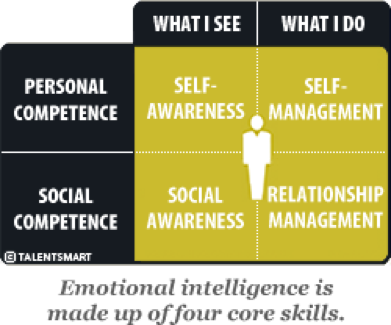Part 1 – Emotional Intelligence in the Workforce Q & A with Coach Andrea M. O’Neal

Interview with Andrea M. O’Neal, Career Prep Coach
Nailing the right skills and having vast career knowledge is fundamental to excelling in any given field. However, beyond having IQ alone, practicing emotional intelligence (EQ) is key to advancing personal leadership and team achievement. Research shows that those with a high EQ and an average IQ outperform peers with a low EQ and high IQ at a rate of 70% and earn an average of $29,000 more annually. Emotional intelligence includes personal competence – the capacity to understand and focus our emotions, strengths, and weaknesses to make sustainable decisions – and social competence – the ability to empathize and respond in a way that demonstrates awareness of how our interactions create accountability and motivate others.
Unlike IQ, EQ is a set of skills that are more flexible to improvement over time and practice. In this two part series, we interview MLT Coach Andrea M. O’Neal for her advice on how to build and use emotional intelligence in the workplace. The first part of this series deals with EQ as it relates to the personal competence of the self.
How do we honestly identify our strengths and weaknesses in our performance and set realistic goals for ourselves?
Andrea: The personal clarity process is important to identifying what we bring to the table and what naturally comes out of our personalities, skillsets, backgrounds, and interests that help us strengthen our performance. Make a long list of how you think about yourself, your values, and the praise you have received. On the other side of that coin, it’s also important to be realistic about the things that may hinder us in a particular work environment. Take the feedback that we have already received in our lives – whether it be from family, friends, colleagues, or past academic or work experiences – and try to make a list of qualities that would be to our advantage in several situations or areas of development that we can shape.
How do we receive feedback without becoming defensive? How do we deliver constructive criticism in a way that doesn’t provoke defensiveness in others?
Andrea: If we receive negative feedback, or what we perceive to be negative, try to process the information by detaching the emotionality from what is being said. Recognize that whoever is giving you this feedback – that is their observation. Whether we feel that it’s fair or true, their opinion deserves to be heard out. Listen intently for the facts of what they’re saying. Assess the same set of facts with your personal experience and decide on whether to address any concerns or inconsistencies.
When giving feedback to others, it’s important to not do so in a way that feels accusatory. There’s a difference between “I” and “you” statements. Delivering positive feedback should be in the “you” context: “You have done a great job on this. You were such a team leader here. You were so dynamic within our team.” Allowing ownership of positive feedback helps reinforce that behavior. If we say “you did this” and “you did that” in a negative context, that person may be more likely to become defensive.
When approaching from a negative feedback standpoint, own your observations: “I observed you not really taking Mary’s point seriously in the meeting. I observed you interrupting her several times.” Preface the conversation by acknowledging an emotional tension: “I would like to talk to you about something, it may be a little uncomfortable, but I feel it’s something we need to move forward with to be able to work effectively together. Would you mind if I shared some of my observations?” Give that person a chance to expect the conversation that is about to happen. Afterwards, give them a chance to respond: “What is your perception of this? How do you feel about what I just said?”
Giving or receiving negative feedback is about moving past an emotional phase to a more solution or action-oriented phase that tends to be more neutral. Asking positive, proactive questions moves the situation to what we hope to see in the future, ideally, a change in behavior: “What can I do to improve? How can we collaborate?” Close the conversation with a summary of the discussion so everyone is on the same page and agrees to move forward.
Giving or receiving negative feedback is about moving past an emotional phase to a more solution or action-oriented phase that tends to be more neutral.
How can we channel our emotions appropriately into the way we work?
Andrea: Emotions are a big one! They can get the best of us sometimes. I took an AMA class called “The Voice of Leadership: How Leaders Inspire, Influence, and Achieve Results” and during that session we discussed Robert Plutchik’s basic emotional charting. What we understand in terms of our emotions are anger, fear, sadness, disgust, surprise, anticipation, trust, and joy. They move on a wheel of fear and anger being the most basic up through trust and joy as the most heightened emotions. When emotions come up for us, we tie them to activities in the workplace. It helps to have an idea of what may be generating this fear about a spreadsheet, or this anger about what my manager just told me, or the joy that I feel when I’m praised for something I’ve done really well. Understanding the root of the emotion before having an external reaction is part of an internal assessment that provides us with a platform to appropriately respond. Feelings about our experiences may be truly internal to us and not affected by the outside world. Bringing those feelings outward could be a detriment to our careers depending on the situation.
How should we react if our ideas are interrupted or overlooked?
Andrea: The first emotion on the wheel might be to become defensive, we all want to be valued for our ideas and opinions, but the fragility of the business’s political environment may not warrant that immediate kind of reaction. Absorb the emotion, acknowledge that it’s something that’s happened, and if it is a grievance worth bringing up. Say you’re in a meeting and you feel like you have something great to bring to the table but you’re the most junior person in the room. You throw your idea out there and it’s dismissed wholeheartedly by people with more experience or someone interjects before you get your whole point out and the topic of conversation is lost to something different. In that situation, it may be hierarchy that causes the dynamic. It could also be based on your own emotional intelligence. You thought it was an appropriate time to bring something up, but maybe it wasn’t. The best advice on how to react is not to react, but to stay in a positive emotional place and remember the strengths that people already value you for in the workplace. However, if it’s a continual thing on your team, then that may be worth mentioning to your manager or trusted colleague to get to a point of better communication within your team.
Check out Part 2 of this series here.


